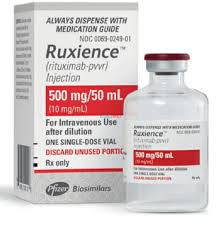RUXIENCE
Reimbursement Ruxience
7/23/20192 min read


A biosimilar to Rituxan®, RUXIENCE® (rituximab-pvvr) is used to treat a number of illnesses, such as rheumatoid arthritis, chronic lymphocytic leukemia, and non-Hodgkin's lymphoma. Appropriate reimbursement depends on accurate billing and coding. This is a handbook to help you:
1. HCPCS Code: Q5119: Biosimilar injection of rituximab-pvvr (10 mg) (RUXIENCE). Report the quantity of units based on the dosage given when billing. A dose of 700 mg, for instance, is equivalent to 70 units (700 mg ÷ 10 mg/unit).
2. Drug Administration CPT Codes:
96413: administering chemotherapy, intravenous infusion; single or first substance/drug; up to 1 hour.
96415: For every extra hour of infusion.
For example, you would use 96413 for the first hour and 96415 twice for the next three hours of a three-hour RUXIENCE infusion.
3. Diagnosis Codes: Verify that the ICD-10-CM codes on the claim support the use of RUXIENCE and correspond to the patient's medical condition. Typical diagnoses consist of:
Non-Hodgkin's lymphoma (NHL): follicular lymphoma (C82.00–C82.99).
o Diffuse large B-cell lymphoma (C83.00–C83.99).
C91.10: Chronic lymphocytic leukemia of B-cell type that has not yet reached remission is known as chronic lymphocytic leukemia (CLL).
oC91.11: B-cell type chronic lymphocytic leukemia in remission.
Several codes for rheumatoid arthritis, both with and without rheumatoid factor, are M05.00–M06.9.
See the Centers for Medicare & Medicaid Services (CMS) billing and coding article on rituximab for a complete list of relevant diagnostic codes.
4. National Drug Code (NDC): Payers may have different requirements for using an 11-digit or 10-digit NDC. For reference, both formats are offered:
One-dose vial containing 100 mg/10 mL: o10-digit: 0069-0335-01 o11-digit: 00069-0335-01
One-dose vial containing 500 mg/50 mL: o10-digit: 0069-0338-01 o11-digit: 00069-0338-01
Make sure to confirm with each payer the precise NDC requirements.
5. Adjustments:
JW: Denotes the quantity of medication that was thrown away or not given to any patients.
JZ: Denotes that no medication has been thrown away or given to a patient.
CMS mandates that the JZ modifier be used to show that no units of a medication were destroyed starting July 1, 2023. The JZ modifier can be used as early as January 1, 2023, however it is not necessary until July 1, 2023.
6. Documentation Standards: Keep thorough medical records that contain the following information: a precise diagnosis and conformity to accepted standards (such as those set forth by pertinent medical groups).
Weight of the patient, if it affects dosage.
A thorough medical history, particularly if previous therapies have been used.
Accurate documentation promotes medical necessity and makes reimbursement procedures run more smoothly.
7. Additional Resources: Refer to the "RUXIENCE Billing and Coding Guide," which provides reimbursement support resources, example claim forms, and coding insights, for more thorough information.
To guarantee correct billing, it's critical to keep abreast of payer-specific regulations and modifications to coding standards.
